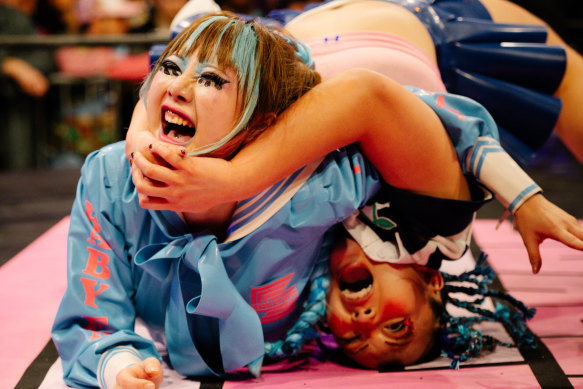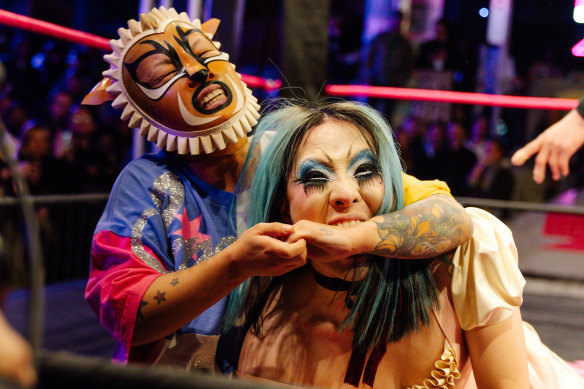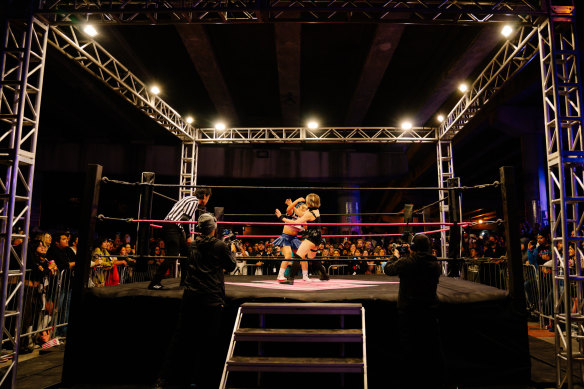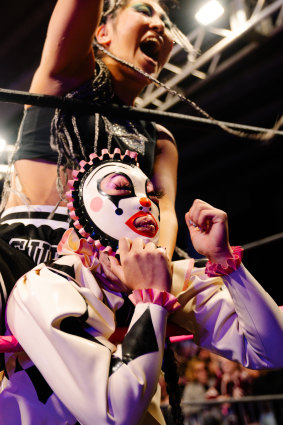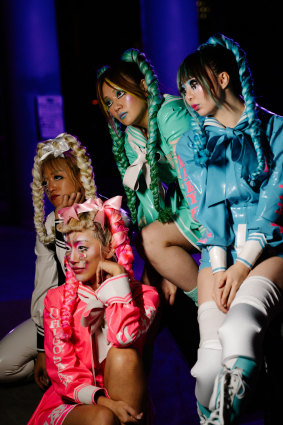Save articles for later
Add articles to your saved list and come back to them any time.
Miami: About 10.30pm on a recent Wednesday, in a downtown skate park under Interstate 95 in Miami, four wrestlers entered a ring: Bingo, Midnight Player, Rina Yamashita and Stray Cat.
More than 1000 people, including men in baseball hats and Miami Dolphins jerseys and one woman holding a small dog, lined metal barricades around the platform. They hollered as wrestlers took their places. The smell of marijuana, and car exhaust from the highway above, filled the air.
Baby Face and Saki Bimi wrestling during a Sukeban match, a unique form of Japanese wrestling that mixes fashion and theatrics.Credit: NYT
Stray Cat, wearing black latex and a feline-inspired mask, faced off first against Bingo, a Harlequin-like character dressed in a white suit covered with black diamonds.
“Stray Cat! Stray Cat! Stray Cat!” the audience chanted.
Bingo lunged forward, thrusting her arm out and thumb down. Stray Cat raised her leg into the air and kicked Bingo in the chest, causing the wrestler to double over. Stray Cat grabbed her opponent’s arm, spun it around her back and threw her in a headlock.
This was Sukeban, a new women’s wrestling league featuring Japanese performers – the first of its kind in the United States.
Supersonic (left) and Lady Antoinette grapple during their Sukeban wrestling match.Credit: NYT
It is one of many leagues dedicated to Japanese women’s wrestling, where athletes often perform theatrical, hard-hitting punches and clever defences while telling a story with their moves and costumes.
Sukeban places a particular emphasis on fashion. Well-known designers, including Olympia Le-Tan, a founder of the league and its creative director, helped to produce the costumes and props with the hope of appealing to an audience unfamiliar with the sport.
On hand for the event was Bull Nakano, the commissioner of the league and a retired professional wrestler who performed in Japan.
“I wrestled for so many years,” she said, through a translator, “and I feel honoured to now be a part of this transformation of Japanese female professional wrestling into more of an artistic and entertaining form.”
Before the event, which was touted as the first Sukeban World Championship and held during Miami Art Week, attendees browsed a Tokyo-style market. They sipped on Orion beer, snacked on popcorn and surrounded the ring in anticipation of the night’s six wrestling matches.
A huge crowd packed around the ring during the Sukeban match in Miami.Credit: NYT
Eighteen wrestlers who compete professionally in Japan participated in the match. They were grouped into four gangs, the Vandals, Cherry Bomb Girls, Dangerous Liaisons and the Harajuku Stars. The athletes, each of whom has a specific persona, battled one another using their costumes, gestures and facial expressions to tell a story about good versus evil, organisers explained.
Riko Blondie holds Bingo in a chokehold.Credit: NYT
In Japanese, the term “sukeban” refers to a “delinquent girl” or “leader of a girl gang” and the name of the league is a nod to the female gangs of the 1960s and 1970s that helped to bring feminism to the fore in Japan.
Le-Tan said the league’s mission was to bring a sport that had been popular in Japan for years, particularly in the 1980s and 1990s, to the United States.
“These young girls would come to watch and be inspired by them, and they would hang posters of them in their room,” Le-Tan said, adding, “That is what we want to bring to today’s generation.”
Organisers are now planning to hold matches across the United States. The league’s first event, held in New York City in September, was sold out, and another match is scheduled to take place in Los Angeles in March.
Notable artists have created memorable looks for the matches. Le-Tan, who has her own housewares and accessories line and has worked with Marc Jacobs, designed the costumes. Stephen Jones, a British milliner whose clients have included Lady Gaga and Princess Diana, made the headpieces. Marc Newson, an Australian industrial designer who is represented by New York’s Gagosian Gallery, created the championship belt.
Sareee, Ichigo Sayaka, Maya Mamushi, and Baby Face before the Sukeban match in Miami.Credit: NYT
Isamaya Ffrench, a make-up artist who has worked with labels including Thom Browne and Off-White, created looks for each character. She focused on highlighting the personalities of each of the wrestlers. “It was all very much an organic response to the clothes,” she said.
Between matches, wrestler Crush Yuu said she was so excited to participate in Sukeban that she quit her last team to join the league.
She said she saw Sukeban as an opportunity for a collaboration between Japanese and American culture, and a chance to expose US audiences to professional female wrestling. She was particularly encouraged by the warm response from the crowd in Miami.
“The US crowd gave me more confidence than I usually have going out there,” she said, through a translator, adding: “And it contributes to my growing love of America.”
As midnight approached and the sound of cheering fans bounced off the interstate above, Ichigo Sayaka and Commander Nakajima entered the ring for the championship match.
While Sayaka spoke to the referee, Nakajima slid behind her, grabbed her opponent by the back of the knee, and hurled her to the ground. The official leaned down on the mat, banged the floor three times, and declared Nakajima the victor.
Bull Nakano climbed under the ropes to present the fighter with the championship belt.
“Ladies and gentlemen, thank you for joining us this evening,” an announcer bellowed. “This is Sukeban!”
This article originally appeared in The New York Times.
Most Viewed in World
From our partners
Source: Read Full Article

